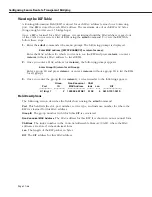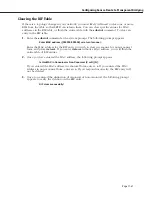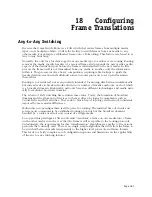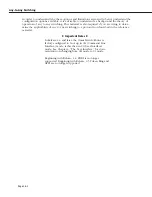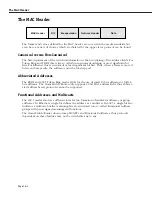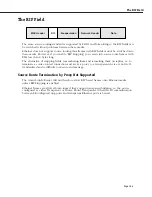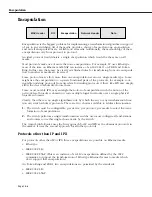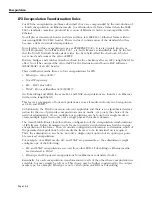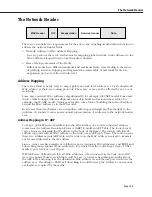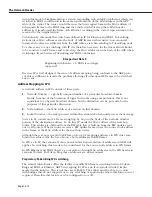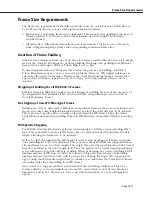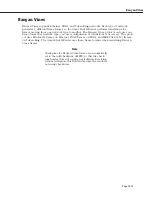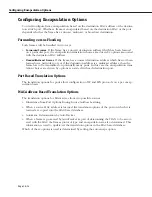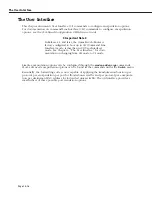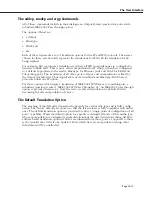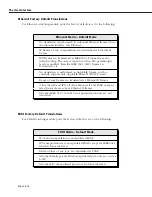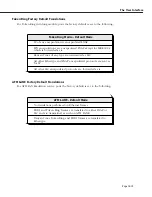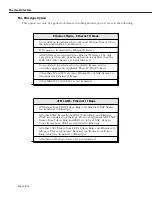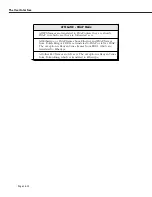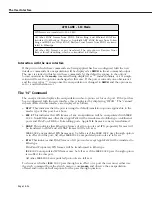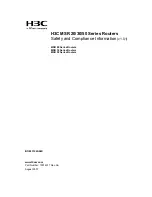
The Network Header
Page 18-10
Given this model of implementation a station responding with an ARP on Ethernet which was
switched to FDDI would result in the same representation of the MAC address in the ARP
table of the router. The router would then use the bit swapped form in the MAC address of
subsequent frames to the FDDI ring and the switch would bit swap these MAC header
address as it transformed the frame onto Ethernet, resulting in the correct representation to be
received by the original station.
Unfortunately, this model has only been defined in IP for Ethernet and FDDI. Token Ring
stations place MAC addresses into the body of ARP frames in their native, non-canonical
format and routers use addresses from the ARP table as is when sending to Token Ring ports.
To achieve any to any switching with IP it is therefore necessary for the Omni Switch/Router
to be sensitive to ARP frames and to bit swap the MAC addresses
in the body of the ARP
when
switching a frame between Token Ring and FDDI or Ethernet.
♦
Important Note
♦
Beginning with Release 4.4, FDDI is no longer
supported.
Because IP is well designed, the issue of address mapping being confined to the ARP proto-
col, this is sufficient to isolate the problem allowing all subsequent IP frames to be switched
any to any.
Address Mapping in IPX
A network address in IPX consists of three parts:
1.
Network Number -- a globally unique identifier of a particular broadcast domain.
Strictly, because of the formation of logical networks using encapsulations, this is not
equivalent to a physical broadcast domain but the distinction can be put aside for the
purposes of this particular discussion.
2.
Node Address -- the MAC address of a station on that domain.
3.
Socket Number -- the task (process) within that station which should process the message.
Just as in IP, routers move a frame along hop by hop on the basis of the network number
portion of the destination address. To do this, IP needs the MAC address of the next hop
router. This address is obtained from the RIP table that is built up from the RIP updates sent
out by all routers. When a router receives a RIP update frame it uses the source node address
in the frame as the MAC address for the next hop router.
Although there is not an explicit ARP like protocol for mapping addresses in IPX, this same
function is achieved by the use of source node addresses in RIP frames.
In IPX, as in IP, the canonical versus non-canonical representation of addresses in ARPs still
applies. In switching, this needs to be considered for the source node address in IPX frames.
In IPX Ethernet and FDDI observe a convention of using MAC addresses in the IPX header in
canonical format. For Token Ring these addresses are non-canonical.
Proprietary Token Ring IPX switching
The Omni Switch/Router offers the facility to modify IPX frames switching between Token
Ring and FDDI or Ethernet. ARP bit swapping for IP is a de facto standard widely imple-
mented in the industry. This is not the case with IPX. The switch must be able to co-exist
with bridges that do not support any to any switching or applications where this feature is not
required. Therefore this feature can be configured on or off.
Summary of Contents for Omni Switch/Router
Page 1: ...Part No 060166 10 Rev C March 2005 Omni Switch Router User Manual Release 4 5 www alcatel com ...
Page 4: ...page iv ...
Page 110: ...WAN Modules Page 3 40 ...
Page 156: ...UI Table Filtering Using Search and Filter Commands Page 4 46 ...
Page 164: ...Using ZMODEM Page 5 8 ...
Page 186: ...Displaying and Setting the Swap State Page 6 22 ...
Page 202: ...Creating a New File System Page 7 16 ...
Page 270: ...Displaying Secure Access Entries in the MPM Log Page 10 14 ...
Page 430: ...OmniChannel Page 15 16 ...
Page 496: ...Configuring Source Route to Transparent Bridging Page 17 48 ...
Page 542: ...Dissimilar LAN Switching Capabilities Page 18 46 ...
Page 646: ...Application Example DHCP Policies Page 20 30 ...
Page 660: ...GMAP Page 21 14 ...
Page 710: ...Viewing the Virtual Interface of Multicast VLANs Page 23 16 ...
Page 722: ...Application Example 5 Page 24 12 ...
Page 788: ...Viewing UDP Relay Statistics Page 26 24 ...
Page 872: ...The WAN Port Software Menu Page 28 46 ...
Page 960: ...Deleting a PPP Entity Page 30 22 ...
Page 978: ...Displaying Link Status Page 31 18 ...
Page 988: ...Displaying ISDN Configuration Entry Status Page 32 10 ...
Page 1024: ...Backup Services Commands Page 34 14 ...
Page 1062: ...Diagnostic Test Cable Schematics Page 36 24 ...
Page 1072: ...Configuring a Switch with an MPX Page A 10 ...
Page 1086: ...Page B 14 ...
Page 1100: ...Page I 14 Index ...



